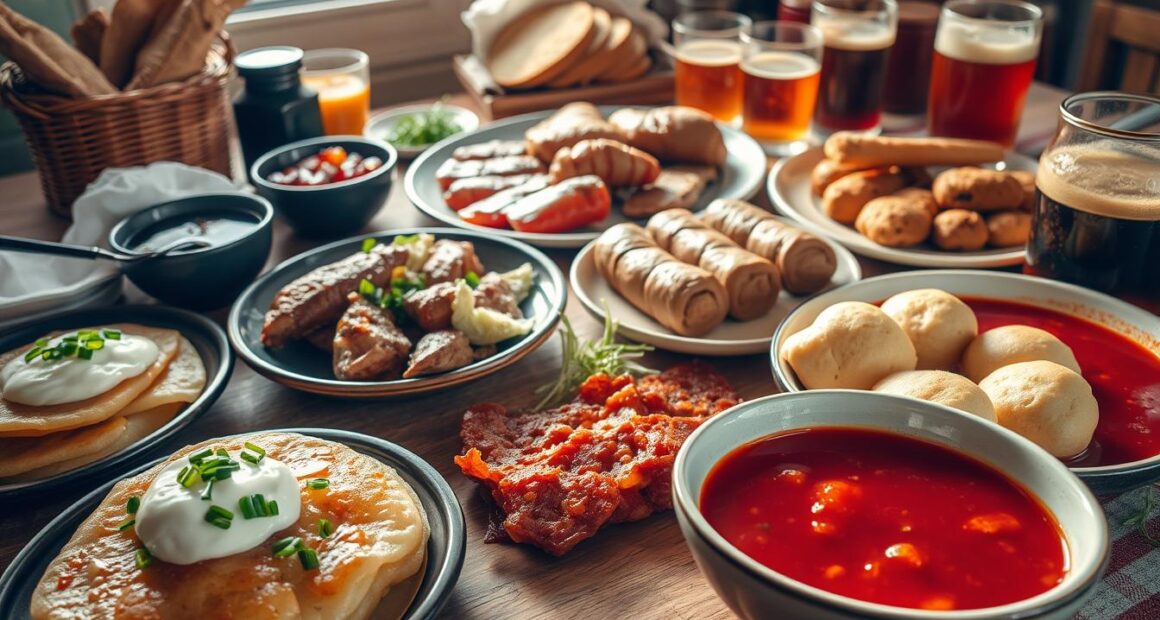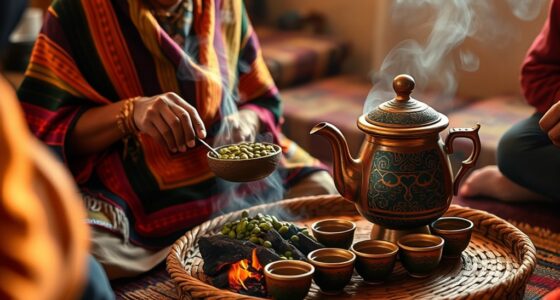Have you ever found yourself reminiscing about a dish that not only nourished your body but also healed your soul? The experience of savoring a comforting meal often transcends mere hunger; it evokes memories, connects us with our roots, and introduces us to the rich heritage of a culture. As you embark on this culinary adventure into Belarusian cuisine, prepare to indulge in the delightful savory flavors that bring warmth and authenticity to the table. Belarusian cuisine is a tapestry woven from centuries of history, blending local ingredients and traditional recipes that echo the resilience and creativity of the Belarusian people. From the iconic potato pancakes to the heartwarming borscht, every dish narrates a story, inviting you to share in an authentic dining experience that celebrates the essence of Eastern European cuisine.
As we explore this flavorful journey together, you will discover why Belarusian dishes have endured through time, offering not just nourishment but also comfort and joy. Each bite reveals the essence of a culture that deeply values community and togetherness, reminding us all of the power of food to unite hearts and create lasting memories.
Key Takeaways
- Belarusian cuisine features local ingredients that highlight the agricultural richness of the region.
- Traditional dishes showcase a blend of historical influences, making each meal a narrative of culture.
- Potatoes play a central role in Belarusian cooking, with unique dishes like draniki taking center stage.
- The cuisine emphasizes comfort food, serving hearty meals that warm the heart and soul.
- Exploring Belarusian food opens a gateway to understanding the country’s traditions and community values.
What is Belarusian Cuisine?
Belarusian cuisine is both simple and hearty, rooted deeply in the availability of local ingredients. This culinary tradition celebrates the flavors of the land, prominently featuring staples like potatoes, meats, and fresh vegetables. It reflects a rich history marked by various historical influences from neighboring Eastern European countries, resulting in a diverse array of traditional recipes.
Historical Influences on Belarusian Dishes
The roots of Belarusian cuisine can be traced back to the 16th century with the introduction of dishes like lazanki. This dish highlights how historical influences shaped food varieties over time. Notably, the first documented appearance of zrazy dates back to the 15th century, pointing to the dish’s significance among the nobility. Such historical elements reveal how access to certain foods has evolved, allowing traditional recipes to permeate everyday life.
Key Ingredients in Traditional Recipes
At the heart of Belarusian cuisine are local ingredients, which form the backbone of traditional recipes. Potatoes hold immense value in the diets of Belarusians, with each person consuming over 180 kg annually, often referred to as “second bread.” Other essential components include pork, mushrooms, and cereals which contribute not only to the flavor but also to the nutritional value of meals designed to withstand long winters. Cooking methods lean towards roasting, cooking, and stewing, fruits of a relationship with the land and seasons.

Popular Belarusian Dishes to Try
Belarusian cuisine showcases an array of remarkable traditional dishes that highlight the country’s rich culinary heritage. Each dish tells a story of local ingredients and the influence of neighboring culinary traditions. You will find that these belarusian recipes not only celebrate the rustic flavors of the region but also provide a delightful introduction to savory flavors that characterize this unique cuisine.
Draniki: The Beloved Potato Pancakes
Draniki are undoubtedly one of the most cherished dishes in Belarus. These thick potato pancakes are crispy on the outside and tender inside, often enjoyed with a dollop of sour cream. Introduced to the Belarusian diet in the 18th century, potatoes quickly became a staple ingredient. The simplicity of draniki allows them to shine, embodying the essence of traditional Belarusian flavors.
Borscht: A Classic Beet Soup
Borscht holds a special place in Belarusian cuisine, showcasing the significant role beets play in local diets. This vibrant soup is often enriched with meat and flavored with vegetables, transforming it into a hearty meal. Unlike its Ukrainian counterpart, Belarusian borscht leans towards a less fatty and spicier profile, allowing the natural sweetness of the beets to take center stage. Enjoying this warm dish is essential for anyone seeking to explore the savory flavors of Belarus.
Machanka: A Hearty Pork Dish
Machanka is a quintessential example of savory Belarusian cuisine, traditionally served during festive occasions. This hearty pork dish is typically accompanied by thick sauces, enhancing its rich flavors. Often enjoyed on Maslenitsa, a holiday celebrated in Belarus, machanka reflects the local preference for robust and satisfying meals. Its comforting nature offers a perfect representation of the beloved traditional dishes of the region.

The Role of Bread in Belarusian Culture
Bread holds a significant place in the cultural culinary heritage of Belarus, symbolizing hospitality and sustenance. As a staple in many households, it reflects the agrarian roots of the nation, particularly through the consumption of traditional bread made from rye. This choice stems from Belarus’ cold climate, which is not suitable for wheat cultivation. Rye bread, characterized by its dense texture and distinctive sour flavor, is a beloved food that showcases the rich bread-making traditions of the country.
Types of Traditional Bread
Belarusian cuisine features a variety of traditional breads, each with its unique characteristics:
| Type of Bread | Main Ingredients | Texture |
|---|---|---|
| Rye Bread | Rye Flour, Water, Salt, Yeast | Dense and Chewy |
| Babka | Potato, Rye Flour, Eggs, Yeast | Soft and Fluffy |
| Bliny | Wheat or Buckwheat Flour, Water, Milk, Eggs | Thin and Pancake-Like |
Bread-Making Rituals and Traditions
Participating in bread-making rituals holds cultural significance in Belarusian communities. These activities often involve families and friends gathering to bake bread together, turning the cooking process into a communal event. This practice not only strengthens social bonds but also keeps the bread-making traditions alive. In Belarus, bread is more than just food; it is a symbol of unity, nourishment, and the warmth of home. The preparation of bread often includes specific customs and gestures, reflecting the deep respect for this essential part of their diet.
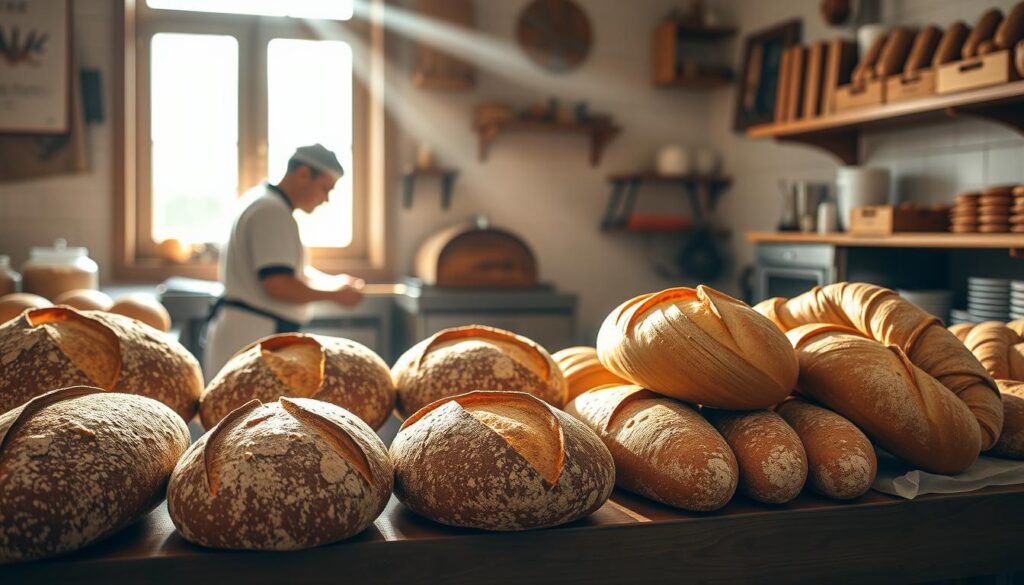
Influence of Neighboring Countries
Belarusian cuisine showcases a rich tapestry of flavors shaped by the influences of neighboring countries. Eastern European cuisine is a collaborative blend that draws from Russian cuisine, Polish impact, and Ukrainian flavors, creating a vibrant culinary landscape. This intermingling reflects cultural exchanges and the adaptive cooking techniques that have evolved over generations.
Russian Cuisine Connections
Russian cuisine shares a significant connection with Belarusian dishes, particularly through hearty soups and stews. Ingredients such as cabbage, beets, and potatoes feature prominently in both culinary traditions. The inclusion of fermented products like kvass reveals a shared appreciation for preservation techniques. Traditional drinks like harelka, made from rye, mirror the spirit of Russian vodka, emphasizing the distinct regional ties.
Polish Culinary Impact
Polish culinary traditions have left a notable mark on Belarusian cuisine. Dishes like kalduny, a type of dumpling, showcase this influence, with the transition from flour-based dough to potato-filled varieties highlighting the evolution of local recipes. The popular cold soup, haladnik, which found its way into Polish cuisine in the late 18th century, exemplifies the cultural melding of these two nations.
Ukrainian Flavor Profiles
Ukrainian flavors play an essential role in enhancing Belarusian dishes, often featuring fresh, locally sourced produce. The emphasis on seasonal vegetables, such as carrots and turnips, resonates with traditional Belarusian practices. Ukrainian cuisine inspires various salads and appetizers, often utilizing ingredients like herring, further enriching the gastronomic diversity of Belarus.
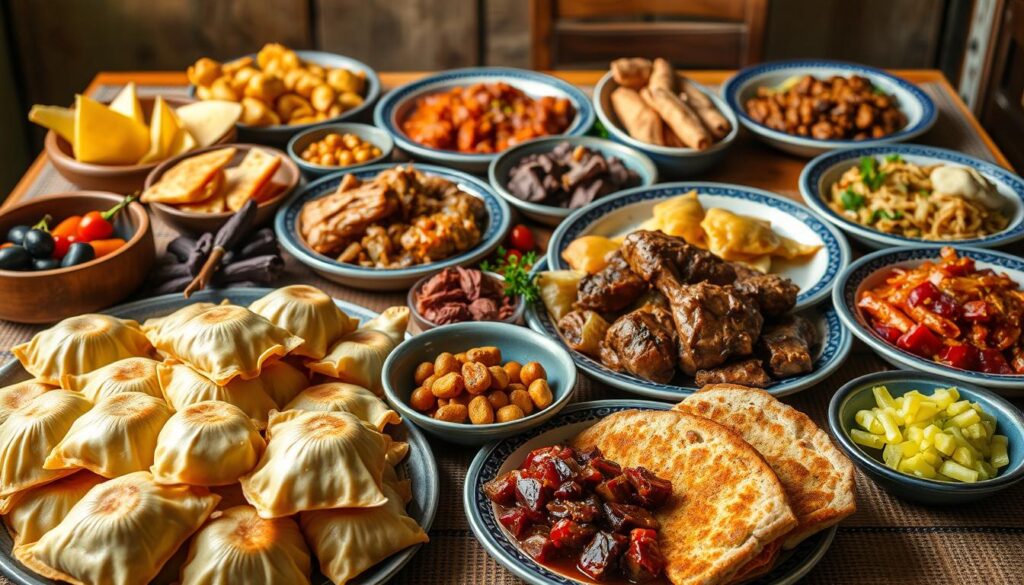
A Guide to Belarusian Desserts
Exploring Belarusian desserts reveals a delightful array of flavors that perfectly balance sweetness with culinary tradition. From the famous honey cake to the innovative savory dumplings, these desserts showcase the creativity and rich history of Belarusian cuisine.
Honey Cake: A Sweet Delight
The honey cake stands out as one of the most beloved belarusian desserts. This multi-layered cake, packed with rich honey flavor, is frequently enjoyed during special occasions and festivals. Often layered with cream or fruit filling, the texture is both moist and decadent, making it a must-try for anyone looking to indulge in authentic Belarusian sweetness.
Kolduny: Dumplings with Flavorful Fillings
Kolduny are often categorized as savory dumplings that contribute to the dessert scene in Belarus. While commonly served as a main course, their diverse filling options—including meat and potatoes—reflect the country’s affinity for hearty flavors. The unique concept of incorporating savory elements in what is generally regarded as a sweet setting exemplifies the inventive culinary spirit found in Belarus.

| Dessert | Main Ingredient | Texture | Serving Suggestions |
|---|---|---|---|
| Honey Cake | Honey | Moist and Layered | With cream or fresh fruits |
| Kolduny | Potatoes or Meat | Soft and Chewy | With sour cream or herbs |
Overall, the interplay of these sweet and savory flavors in belarusian desserts underscores the country’s culinary diversity and commitment to fresh, local ingredients.
Seasonal Ingredients in Belarusian Cooking
Belarusian cuisine thrives on the rich tapestry of local ingredients and the natural rhythms of seasonal cooking. Utilizing fresh produce not only enhances flavors but also nurtures a deep connection to the land. Traditional practices emphasize the importance of using what is available during each specific season, creating dishes that resonate with the vibrant landscape of Belarus.
Importance of Fresh Produce
The value placed on fresh produce is paramount in Belarusian cooking. Seasonal cooking reflects the agricultural bounty of the region, with root vegetables dominating the winter months while summer brings a wealth of leafy greens, berries, and fruits to the table. This reliance on local ingredients leads to dishes that celebrate the integrity and freshness of every component. From the beloved draniki, made of freshly grated potatoes, to babka served with creamy sour milk, each dish showcases a commitment to utilizing what is at the height of its flavor and quality.
How Seasons Influence Popular Dishes
Seasons significantly influence the popularity of dishes in Belarus. For instance, cold soups, traditionally made from ingredients like beets and sorrel, are particularly favored in the warmer months, providing a refreshing contrast to heavier fare. On the other hand, hearty meat dishes, such as vereshchaka, shine during the colder seasons as they offer warmth and nourishment. The presence of mushrooms, a key local ingredient, varies with the seasons, allowing for their unique flavors to be integrated into various dishes, from stews to dumplings. Embracing this cycle of seasonal cooking fosters a sense of tradition and pride within the culinary landscape of Belarus.

Celebrating Belarusian Holidays with Food
Food plays a pivotal role in Belarusian holidays, intertwining with rich cultural culinary heritage. Each festive season welcomes an array of traditional holiday dishes, celebrated with unique customs passed down through generations. Christmas and Easter, in particular, showcase the essence of these culinary traditions, emphasizing family and community connections.
Traditional Dishes for Christmas
Orthodox Christmas, celebrated on January 7th, boasts a vibrant array of traditional holiday dishes. The Christmas Eve dinner often features twelve dishes, symbolizing the twelve apostles, and serves as a representation of abundance. Integral to this feast is kutia, a sweet porridge made from wheat or barley, often enriched with dried fruits and nuts. The average family meal may include:
| Dish | Ingredients | Symbolism |
|---|---|---|
| Fish | Carp, perch, or pike perch | Purity and salvation |
| Cabbage rolls | Cabbage, mushrooms | Procreation, peace |
| Baked apples | Raisins, honey | Protection against diseases |
| Borscht | Beets, cabbage, and beans | Fasting and reflection |
Many families follow the practice of preparing varied vegetable dishes, such as beet soup and potato pancakes. This emphasis on seasonal ingredients reflects the cultural culinary heritage of Belarus. Christmas decorations, often including straw ornaments and colorful lights, add to the festive atmosphere.
Easter Foods and Customs
Easter, a time of renewal, features its own special foods and belarusian customs. Families typically prepare and bless an array of foods that symbolize resurrection and joy. Traditional dishes include painted eggs, cottage cheese desserts, and specially baked breads, emphasizing the communal spirit during this festive time. The focus on shared meals highlights the importance of family unity, central to Belarusian traditions.
As you explore or celebrate these holidays, remember that the cultural culinary heritage of Belarus brings families together through food, creating cherished memories rooted in the heart of their traditions.

Food Pairings to Complement Belarusian Meals
Enhancing your meals with thoughtful food pairings can elevate your authentic dining experience. When enjoying classic Belarusian dishes, selecting the right beverages and side dishes is essential. These choices not only complement the meal itself but also embrace the rich flavors that Belarusian cuisine has to offer.
Popular Beverage Choices
When it comes to beverage choices, several traditional drinks perfectly accompany Belarusian meals. Kvass, a non-alcoholic beverage made from fermented bread, brings a tangy sweetness to the table. For those seeking something warm, sbiten, a spiced honey drink, is particularly comforting during the colder months. Vodka, a staple in many Eastern European cuisines, can serve as a robust choice, while herbal teas offer a soothing complement to lighter dishes.
Side Dishes to Enhance Flavors
Side dishes play a pivotal role in enriching the palate. Consider serving pickled vegetables, which add a zesty contrast to the savory main courses. Sautéed greens, bursting with freshness, enhance many traditional dishes. Other popular options include hearty cereals or bread, notably rye, that provide depth and texture, ensuring that every bite contributes to a delightful dining experience. By thoughtfully curating your food pairings, you can truly indulge in the diverse flavors and traditions of Belarusian cuisine.
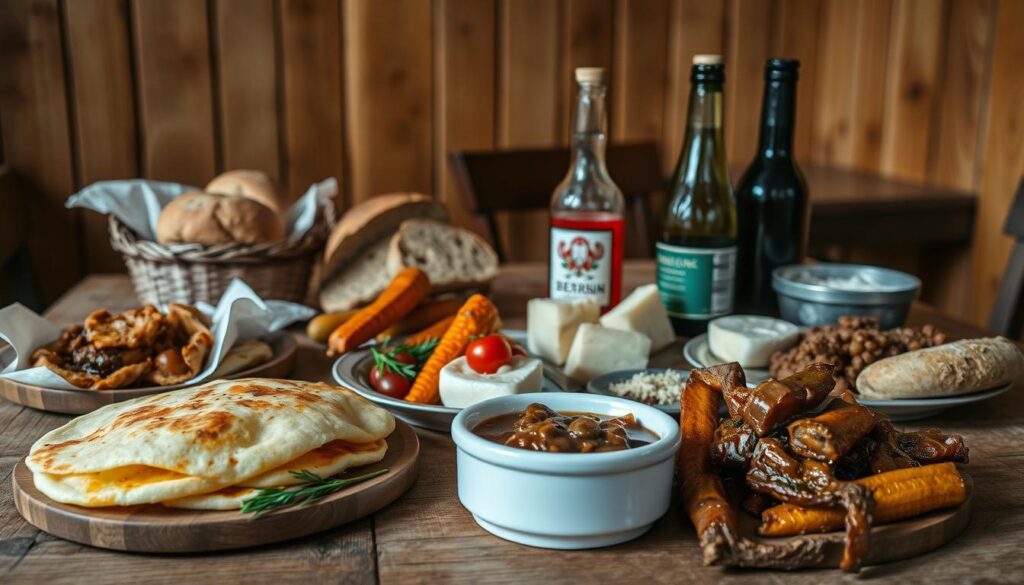
Exploring Belarusian Street Food
Street food in Belarus presents an exciting opportunity to embrace the local flavors as you explore the vibrant culinary landscape. Food stands often serve up a selection of belarusian snacks made with fresh and local ingredients, allowing you to experience the essence of Belarusian culture in a quick bite. This approach provides a convenient and delicious way to discover the heart of what the country has to offer.
Discovering Local Food Stands
Visit local food stands to savor the authentic tastes of Belarus. Many vendors focus on using local ingredients, highlighting regional specialties. Some popular offerings include:
- Potato draniki, a classic dish made from grated potatoes, often served with sour cream.
- Fried pastries, which might be filled with savory meat or creamy cheese, bursting with flavor.
- Stuffed cabbage rolls, a hearty snack that encapsulates traditional Belarusian cooking.
Must-Try Street Snacks
When venturing into the Belarusian street food scene, certain belarusian snacks should not be missed. Each bite reflects the country’s rich culinary heritage, embodying local ingredients and customs. Consider trying:
- Draniki – Crispy potato pancakes that are a staple throughout Belarus.
- Pirozhki – Small buns filled with various fillings such as meat, potatoes, or cabbage.
- Syrniki – Sweet cheese pancakes often accompanied by fruit or jam.

Cooking Techniques Unique to Belarusian Cuisine
Belarusian cuisine is rich and diverse, where traditional cooking techniques play a significant role in your culinary experience. Mastering these cooking methods not only enhances the flavor of dishes but also preserves the culinary heritage that has been passed down through generations. You will find that boiling, stewing, baking, and roasting are fundamental to crafting authentic recipes that define this unique cuisine.
Boiling and Stewing
Boiling and stewing create hearty meals that comfort and nourish. These cooking techniques are incredibly common in Belarusian kitchens. Soups, such as borscht, are often made through this method, allowing the rich flavors of vegetables and meats to meld beautifully. Ingredients like potatoes, cabbage, and beets come alive during the cooking process, embodying the essence of Belarusian dishes.
Baking and Roasting
Baking, especially with rye flour, holds a special place in Belarusian cuisine. The traditional bread and pastries much loved by locals stem from this method. You may encounter rye bread at nearly every table, showcasing the true meaning of culinary heritage. Roasting is another vital technique used during festivities, ensuring that every meat and vegetable dish achieves a deep, delicious flavor. Whether it’s a holiday banquet or a family gathering, roasting elevates the dining experience and highlights authentic recipes cherished by Belarusians.
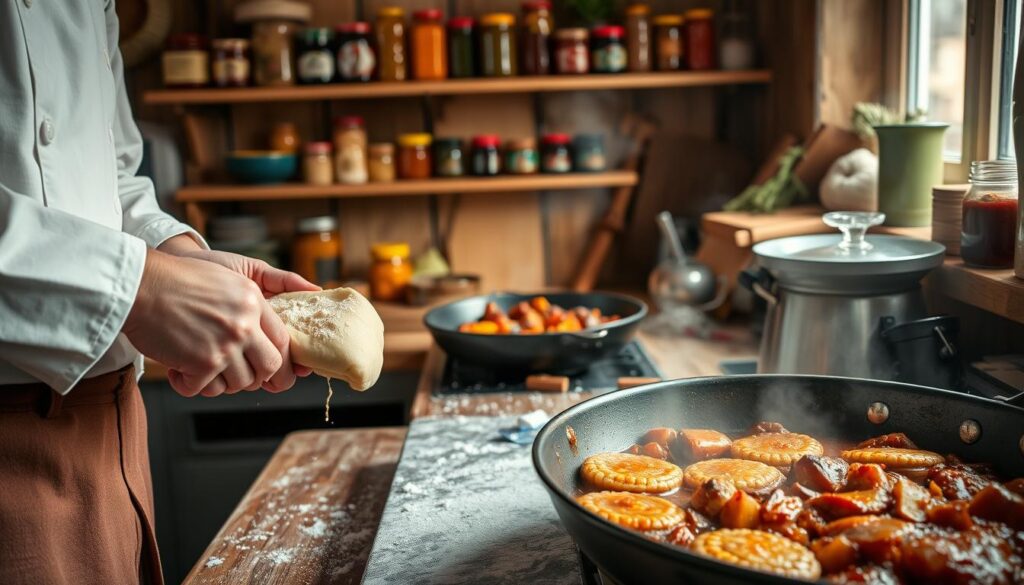
By embracing these cooking techniques, you will appreciate the flavors and traditions that define Belarusian cuisine. Each method brings a distinct charm, making your culinary journey an authentic adventure.
The Art of Hosting a Belarusian Feast
Embracing the art of hosting a Belarusian feast offers a wonderful chance to share an authentic dining experience with family and friends. Central to this experience are traditional dishes that not only taste delicious but also carry deep cultural significance. As you plan your gathering, consider incorporating a variety of foods that honor Belarusian heritage while providing a warm and inviting atmosphere.
Essential Dishes for a Gathering
Your menu should feature beloved traditional dishes such as:
- Draniki – Crispy potato pancakes that everyone loves.
- Borscht – The classic beet soup that captivates with its rich flavor.
- A selection of breads – Fresh, homemade breads serve as the heart of many meals.
Each of these dishes contributes to an authentic dining experience, bringing flavors to life that resonate with Belarusian history.
Tips for Creating the Right Atmosphere
Creating the ideal ambiance is just as important as the food. Here are some hosting tips to set the right mood:
- Choose rustic decor that reflects the charm of Belarusian culture, such as traditional textiles and handmade ceramics.
- Utilize low lighting to enhance a cozy setting that encourages conversation and connection.
- Encourage guests to share stories related to the food, fostering a communal spirit around your table.
By focusing on the ambiance and quality of your traditional dishes, you can ensure that your gathering is a memorable occasion filled with warmth and flavor.
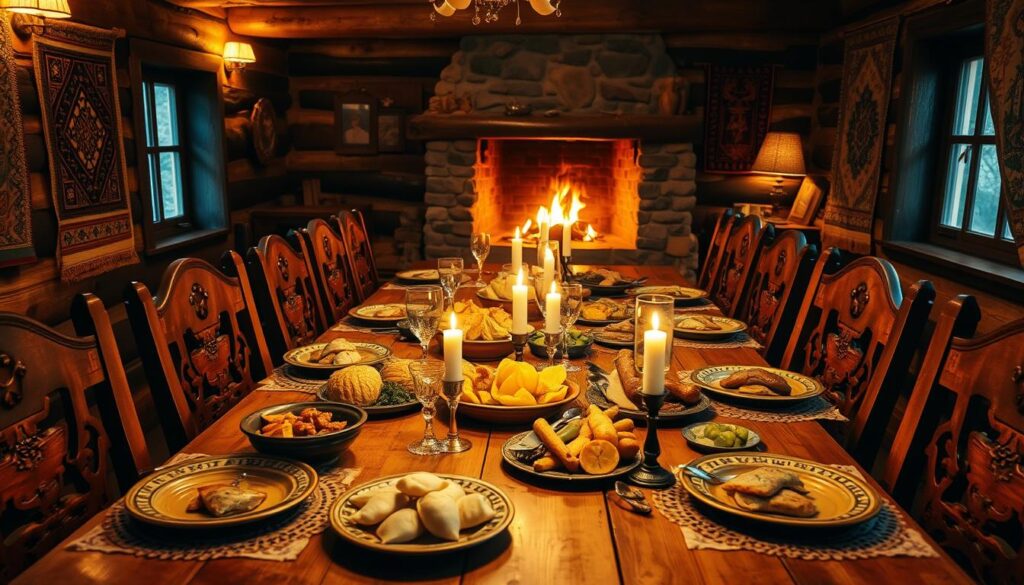
Modern Takes on Traditional Recipes
The culinary landscape of Belarus continues to evolve, blending traditional flavors with innovative techniques. Modern recipes bring a fresh perspective to beloved dishes while integrating elements from global cuisines. This experimentation allows chefs to create unique fusion dishes that maintain the essence of Belarusian cuisine yet appeal to contemporary palates.
Contemporary Twist on Draniki
Draniki, the iconic Belarusian potato pancakes, have found their way into modern kitchens with exciting variations. Chefs are incorporating different toppings, such as smoked salmon or avocado, adding a layer of sophistication. Another trend includes adding spices and herbs to the batter, resulting in pancakes that cater to diverse taste preferences while honoring the dish’s historical roots.
Fusion Dishes Inspired by Belarusian Flavors
Fusion dishes are gaining traction within Belarusian cuisine, as chefs draw inspiration from various international culinary traditions. Ingredients typical of Belarusian cuisine, such as mushrooms and potatoes, are paired with Asian techniques, creating dishes like mushroom risotto with a hint of dill or spiced potato dumplings served with Asian-style dipping sauces. These modern interpretations not only highlight the versatility of traditional ingredients but also reflect a commitment to culinary creativity.
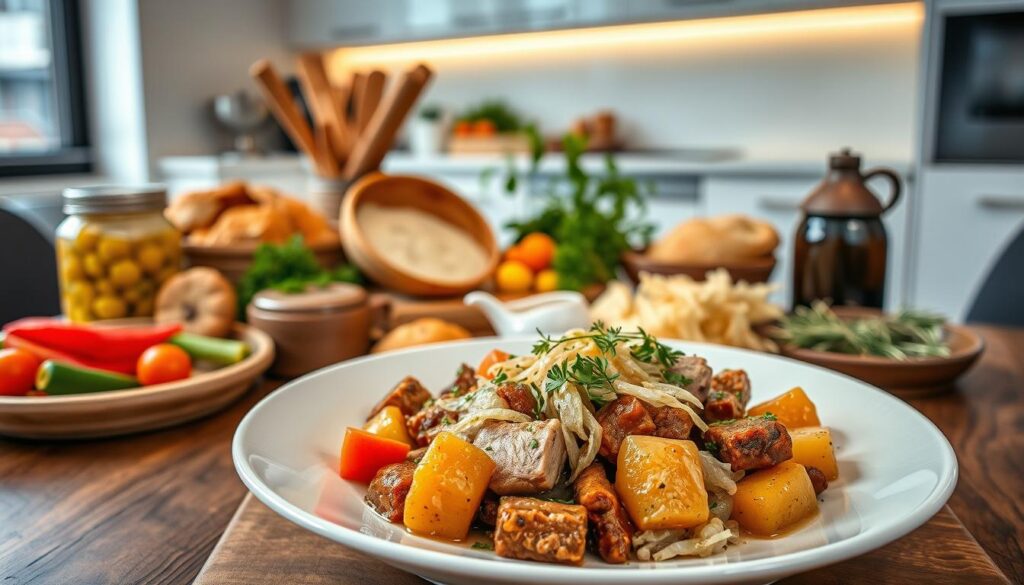
| Traditional Dish | Modern Variation |
|---|---|
| Draniki | Draniki with avocado and smoked salmon |
| Machanka | Machanka-stuffed tacos with spicy salsa |
| Kolduny | Asian-style dumplings with pork and ginger |
| Traditional Mushroom Soup | Mushroom and coconut curry soup |
Learning from Belarusian Cooking Classes
Participating in cooking classes focused on Belarusian cuisine offers an exciting way to delve into the rich culinary heritage of Belarus. You can expect to engage in hands-on experiences while learning essential techniques and traditional recipes from experienced chefs. This form of culinary education fosters a deeper understanding and appreciation for the vibrant flavors and unique ingredients found in Belarusian cooking.
What to Expect in a Class
In these cooking classes, you will discover various formats that cater to different learning preferences. Some sessions focus on active participation, allowing you to roll up your sleeves and cook alongside experts. Others may offer observation, where you can watch master chefs demonstrate techniques before trying them yourself. Expect to learn about key ingredients, including staples like potatoes and dairy, while preparing well-loved dishes such as draniki and kolduny.
Popular Schools and Chefs to Follow
Several culinary schools and renowned chefs highlight the opportunity for you to expand your skills through specialized workshops. Organizations are dedicated to gastronomic tourism, providing classes that encompass not just cooking but also the stories and cultural significance behind each dish. Keep an eye on notable events such as Gastrofest in Minsk or local culinary quests, which not only offer learning experiences but also a fun and interactive atmosphere. Popular chefs known for their expertise in teaching learning Belarusian cuisine will guide you, ensuring an enjoyable and educational culinary journey.

Where to Discover Belarusian Cuisine in the U.S.
Exploring Belarusian cuisine in the United States opens up a world of flavors that reflect the rich culinary heritage of Belarus. You can find belarusian restaurants that specialize in traditional dishes, inviting you to savor authentic tastes from the heart of Eastern Europe. Not only do these establishments serve mouthwatering meals, but they also foster an appreciation for local cuisine through various events.
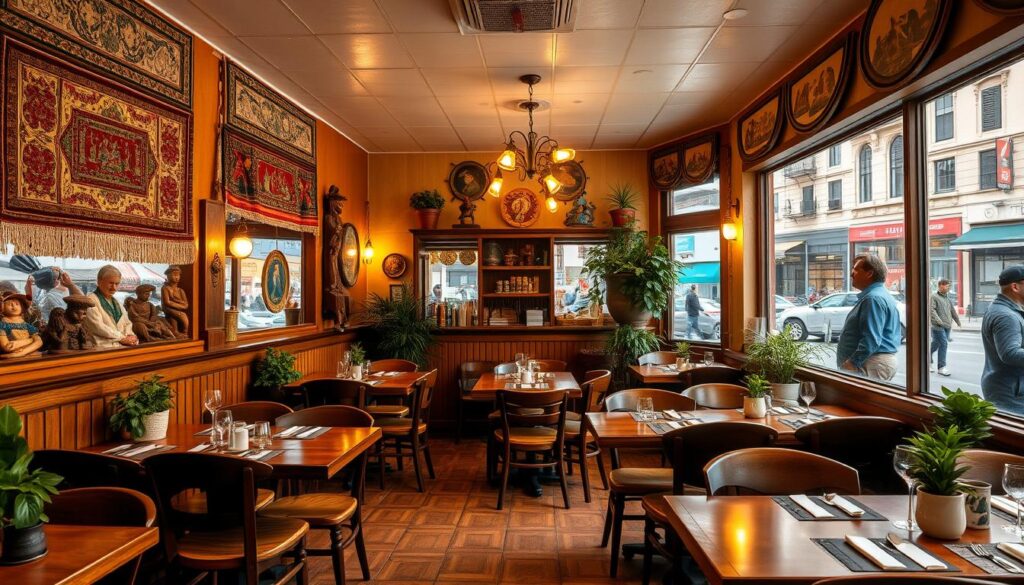
Notable Restaurants to Visit
Among the thriving belarusian restaurants in the U.S., some stand out for their dedication to authenticity and flavor. These dining spots often offer a menu filled with local cuisine, showcasing beloved dishes such as:
- Draniki – Fried potato pancakes served with sour cream.
- Borscht – A hearty beet soup, boasting variations in spice levels.
- Zhurek – A sour bread soup with historical significance.
- Shkvarki – Fried pork bits, perfect for pairing with drinks.
Food Festivals Featuring Belarusian Flavors
Food festivals provide a vibrant platform to celebrate Belarusian culture through its culinary delights. Events like the Belarusian cuisine celebration at NetCost Market allow you to enjoy freshly prepared dishes while learning more about their historical background. Visitors can experience:
| Event | Date | Highlights |
|---|---|---|
| Belarusian Cuisine Celebration | February (two weeks) | Daily presentation of authentic dishes |
| Eastern European Food Festival | Summer | Showcasing various regional foods |
These festivals not only present an opportunity to taste local cuisine but also act as hubs for community engagement, celebrating food, music, and local artisans. Joining in on these events will deepen your understanding of Belarusian culinary artistry while connecting you with others who share a passion for diverse flavors.
Conclusion: Your Next Culinary Adventure Awaits
As you embark on your culinary adventure exploring the vibrant world of Belarusian flavors, remember that every dish tells a story filled with tradition and warmth. From the beloved potato pancakes known as draniki to the tanginess of beet borscht, Belarusian cuisine offers a delightful array of tastes that can enhance your cooking repertoire. Exploring these diverse dishes not only tantalizes your palate but also connects you to the rich cultural heritage of Belarus.
Embrace the Flavors of Belarus
Diving into Belarusian cooking can be an inviting challenge filled with rewarding discoveries. To get started, focus on sourcing local ingredients that mirror the essence of Belarusian flavors. Honor time-tested methods, such as boiling and stewing, to capture the authentic spirit of these recipes. Moreover, don’t shy away from experimenting with different variations to suit your own preferences while maintaining the traditional roots.
Cooking Tips for Getting Started
Begin your journey by incorporating simple yet foundational recipes into your meal rotation. Look for resources like cookbooks or online classes that emphasize Belarusian cooking techniques. As you refine your skills, share your creations with friends and family, fostering connections through food. With a little patience and creativity, you’ll be well on your way to mastering these delicious dishes, making your culinary adventure even more fulfilling.
